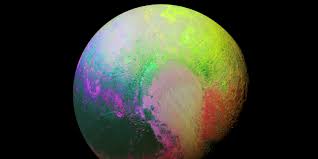Overview
Since the New Horizons spacecraft flew by the dwarf planet Pluto on July 15, 2016, downloaded photographs have revealed more puzzling features. More will still come, as only about half the data gathered during the flyby has reached Earth.
Pluto’s Subsurface Ocean
Some of the latest data suggest that there may be an ocean under the surface of Pluto, similar to the frozen oceans on Saturn’s moon Enceladus and Jupiter’s moon Europa. It may be made of liquid water or other substances, since some areas of Pluto have methane ices, nitrogen ice, and carbon monoxide ice. The best way to explain some of the geologic activity on Pluto is by movement of an ocean under the surface, creating energy from the rotation of the planet.
Geological Activity
Pluto is much more geologically active than was once thought. A large ice plain named Sputnik Planum is covered by nitrogen ice, carbon monoxide ice, and methane ice. It is at the western part of the heart-shaped area, and has very few craters. This flat plain is through to be only about 10 million years old, with glaciers made of nitrogen. It is bordered by several mountain ranges and hills that might be made of floating ice. By contrast, Pluto’s largest moon Charon has surface features that are about 4 billion years old.
Formation of Pluto
Scientists have examined evidence from photographs from the New Horizons flyby of the Pluto system. They theorize that Pluto and its largest satellite Charon are part of a binary system, and that the other smaller moons are a result of the collisions that resulted in the formation of Pluto and Charon. Pluto’s satellites are more reflective than other bodies in the Kuiper Belt, leading scientists to infer that their composition is different.
Mysterious Pluto
Some areas on the surface of Pluto are methane ice, while others are nitrogen ice, still others are carbon monoxide, or water ice. The differences in surface composition have nothing in common with the rest of the bodies in the outer Solar System. The atmosphere of Pluto is colder than expected, and consists of thin, hazy bands of nitrogen and methane.
Interested in science tutoring services? Learn more about how we are assisting thousands of students each academic year.
SchoolTutoring Academy is the premier educational services company for K-12 and college students. We offer tutoring programs for students in K-12, AP classes, and college. To learn more about how we help parents and students in Hartford, CT: visit Tutoring in Hartford, CT





